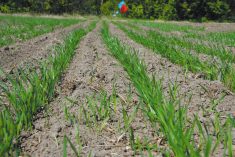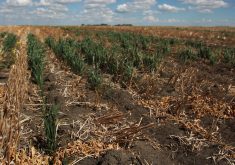Countries in North Africa, major customers for durum wheat, are experiencing a dry start to their growing season.
Morocco, Algeria and Tunisia together are usually in the top ranks of buyers of Canadian durum wheat, used to make the staple dish of couscous.
Farmers in Morocco, Algeria and Tunisia this month are wrapping up seeding their winter wheat that will be harvested in May and June.
Clearly there is lots of time for rain yet, but producers are on edge about the dry start. Moroccan farmers are particularly worried about a repeat of last year’s disappointing yields caused by drought.
Read Also

Huge Black Sea flax crop to provide stiff competition
Russia and Kazakhstan harvested huge flax crops and will be providing stiff competition in China and the EU.
The U.S. Department of Agriculture weekly weather and crop bulletin for the week ending Dec. 31 said drought intensified during the week in Algeria and Tunisia under sunny skies and temperatures up to 7 C degrees warmer than normal.
From Sept. 1 to the end of December, rainfall in areas adjacent to the Mediterranean Sea in eastern and western Algeria and northern Tunisia were the driest of the past 30 years. Rain accumulations were at or below 50 percent of average.
North-central Algeria saw the second driest period of the last 30 years with 55 percent of normal rainfall.
Morocco got some relief with rain in the first half of December but turned dry again in the second half of the month.
The Vegetation Health Index in Morocco was the third-lowest on records dating back to 1982, according to the report.
Morocco can produce the most wheat of the three North African countries, in some years growing more than seven million tonnes, but last spring it harvested only 2.7 million tonnes, down from 7.54 million the year before.
Last spring, Algeria harvested an average crop of 3.7 million tonnes, up from a disappointing 2.5 million the year before.
Tunisia harvested an average crop of 1.2 million tonnes, about the same as the year before.
All three enjoy a Mediterranean climate in coastal areas where most of the agriculture occurs. The rainy season runs from October to April.
Much of their wheat imports come from Europe, but Canada is a major source of durum.
Canadian Grain Commission weekly exports statistics show Canada’s durum exports are recovering from last year’s drought-reduced production and shipments.
For the crop year to Jan. 1, the 22nd week of the shipping campaign, Canadian durum exports stand at 1.942 million tonnes, well up from 1.182 million at the same point last year, but behind the pace in 2021 at 2.47 million and 2020 at 2.15 million.
Durum exports this year are slightly behind the pace needed to reach the Agriculture Canada forecast of full year exports at 4.8 million tonnes.
By comparison, exports of other wheat are running ahead of the pace needed to meet the forecast of 18.9 million tonnes.
The CGC’s report on export destinations is available for November, the fourth month of the crop year.
It shows Italy as the top durum buyer at that point, importing 540,500 tonnes, up from 229,600 tonnes at the same point last year.
The number two buyer was Morocco at 197,600 tonnes, down from 328,800 tonnes last year.
The number three buyer was the United States.
In fourth place was Algeria at 171,300 tonnes, up from 26,600 last year.
Tunisia imported 101,300 tonnes, up from 18,900 tonnes last year.
Reuters reported in mid December that Tunisia had bought 125,000 tonnes of durum for delivery between Jan. 10 and Feb. 25. Of that Richardson captured 50,000 tonnes and Viterra 25,000 tonnes.
As for durum prices in Canada, it appears the cash value has been stable in the autumn and early winter, according to the PDQinfo.ca website.
It shows No. 1 Canadian Western Amber Durum in the C$490-$500 per tonne range, or roughly $14.40-$14.60 per bushel. That price is however down from the level in the fall of 2021 when it was around $750 per tonne.
Spring wheat cash has also been surprisingly stable since October, in contrast to the decline in the Minneapolis spring wheat futures, which has fallen by about 60 cents U.S. per bushel from October to slightly more than $9 in early January.
Looking at prices for northwestern Saskatchewan on the PDQinfo.ca website, the cash-to-futures basis for spring wheat has improved in the farmers’ favour over the fall, moving from around -C$50 a tonne in early October to -$30 to -$25 in December.
As for competition from the European Union, Strategie Grains on Dec. 15 pegged the community’s durum production for this year at 7.1 million tonnes, down from its November estimate of 7.2 million.
That is down from the previous year’s 7.7 million tonnes.
It forecast that farmers this fall had seeded 5.93 million acres to winter durum, down from 6.18 million last year.

















